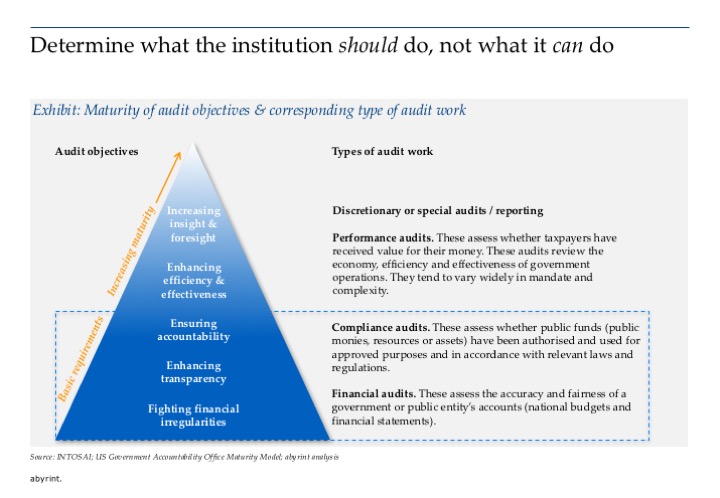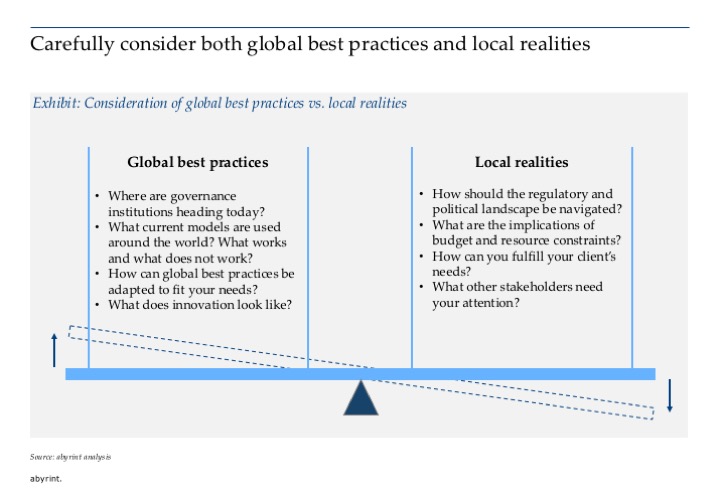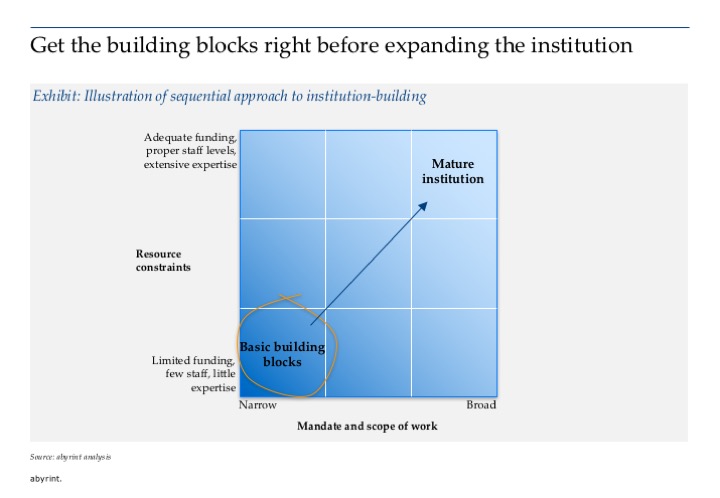Institutional Design: Establishing Supreme Audit Functions in Post-Conflict States
Published on: Fri Mar 18 2016 by Stina Haerum
In an extreme low capacity environment with a newly formed government, how do you build robust governance institutions that will guarantee accountability? Where do you begin when there is a blank slate? Starting from scratch may sound ideal at first, but there are many challenges to solve along the way. Start by focusing on the key strategic questions, on what is truly critical to launch the institution. By intentionally leaving some decisions on the backburner until later, efforts can center on developing the basics. Then, using a structured management process, the building blocks can be expanded upon.
1. Setting the overall direction:
Understand the implications of the legal framework.
The defining characteristics of a governance institution are often prescribed in the country or territory’s legal framework. How developed this framework is can have a huge effect on the institution’s ability to effectively deliver on its mandate. However, when building a governance institution from scratch, little may be defined by law. Hence, supporting legislation may be required to define the institution’s foundations and establish its authority. In such cases, alignment with fundamental legal principles as well as with the local Constitution is critical. Legislation must support the existing legal framework, while providing enough authority for the institution to govern and grow over time.
Determine the institution’s objectives.
Focus on understanding the core mandate of the institution, and within this, what work is indispensable and what is discretionary. Determine what the institution should do, not what the institution can do. For an external audit institution, objectives can be defined using a maturity model, whereby requirements move from basic to complex. As the institution increases in maturity, more advanced objectives can be fulfilled. Conversely, for a newly established or immature institution, only the basic requirements should be delivered at first. Recognizing that an embryonic institution should not ‘do it all’ will help to narrowly define its objectives, thus limiting the scope and nature of its work.
Exhibit 1 Maturity of audit ambition/objectives and corresponding types of audit products

Balance global best practices with local realities and constraints.
Much inspiration can be sought from global best practices and recommendations. However, it is important to be cautious as local realities and constraints may render these recommendations less useful. Common practices around the globe should be analyzed to gain an understanding of how governance institutions perform today and what successful models exist. What are the pros and cons of each model? The answer to this question can then be weighed against the needs dictated by the local environment. From the regulatory environment and political dynamics to the needs of the client and stakeholders, a solid understanding of the context will help inform the institution’s design.
Some of these issues may reflect preferences where choices will need to be made, but there will also be some hard constraints. This will likely include budget or resourcing limitations: is there a budget already set aside for the new institution? Is the budget flexible and is it ambitious? How hard is it to recruit key leadership? What skillsets are required, and available, to run the institution? Often times these questions lead to answers that will limit the design of the institution, making it all the more important to focus on the basics. Lastly, certain pre-requisites likely have to be met before the institution can be built in the first place. For a governance institution, this typically means the passage of new legislation or amendment of a law. These are critical issues that should be carefully mapped out before any ‘building’ begins.
Exhibit 2

2. Building, block by block:
Start small but be aspirational
When building an institution from scratch, there are no pre-existing processes or know-how to leverage, nor is a legacy structure in place. In addition, lack of expertise, financial resources and capacity may prevent the organization from realizing its full potential in its early years. Furthermore, there is always much uncertainty about the future, particularly in a low capacity or fragile environment. Thus, although the ambition may be to build a world-class institution that complies with international best practices, this is not practical to implement in the start-up phase.
In a version 1.0, it is perhaps most realistic to aim for an institution that can deliver the basics. That may imply a focus on the fundamental building blocks in the early days, leaving the sophistication for a version 2.0.
Aspirations for the institution will evolve over time. However, initially it is useful to have clarity on the following areas in order to build the capability of the institution:
- External accountability and operational independence. What should the external reporting and governance structure look like? Does the institution report to parliament? Is this enshrined in a law? Does the institution have operational independence, i.e. budget authority?
- Scope of powers and mandate. This is critical to building the operational capability to deliver on its core work. For an external audit institution, this means focusing on the core financial audit work and, as the institution matures, expanding into compliance and performance audits and investigations.
- Internal accountabilities. A basic internal reporting structure should be present. Any new institution will however need to live with some ambiguity of internal roles as well as possess much entrepreneurial spirit and determination.
- Talent. Identify the core roles and skillsets needed to launch the institution. The right leadership, a person or persons capable and motivated with the necessary hard skills (i.e. for an audit institution this includes an internationally-recognized certification in accounting), is key to success.
This approach will allow the institution to first focus on establishing the quality and utility of its work and build its reputation to external stakeholders before expanding.
3. Employ a pilot approach to growth.
To expand on the core building blocks, there should be a deliberate sequencing of institution-building processes over time. By building its functions on an incremental basis, block by block, this will allow the institution to adequately absorb new tasks while minimizing the risks of growing too fast.
Exhibit 3 Determine balance of resource vs ambitions

As it scales up, the institution should test its vision continuously. By employing a structured management approach, the institution can ensure it tests new processes as it grows. Before each desired increase in scope of work, a small pilot can be run in order to test the proposed approach, methodology, and readiness of the institution. Feedback from the pilot should be reviewed and plans updated accordingly based on the outcome. Before officially launching the new work, lessons learned from the pilot should be institutionalized. As the institution continues to grow, the feedback loop and learning from pilots should be perpetual.
Building an accountability institution is not rocket science. Governments around the world provide such services and much of the work is well codified, particularly for an external audit function. However, delivering accountability is a challenge of another level. Many institutions exist, and function seemingly well, but are unable to deliver on their mandate. Guaranteeing accountability is hard to accomplish anywhere, let alone in a low capacity environment. Starting from scratch provides a unique opportunity to do this right. With the proper focus and entrepreneurial drive, the foundations of an effective institution can be built to deliver on its vision, thus enhancing trust between the government and its citizens.
Stina Haerum is a senior associate @abyrint



